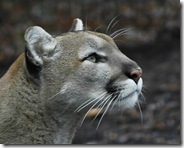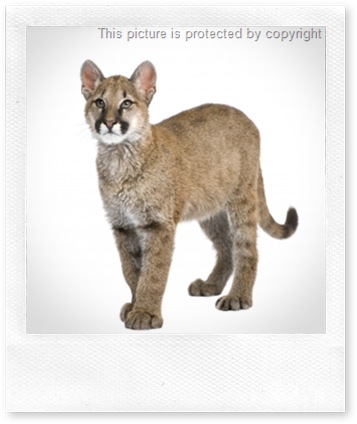
This is a leading or links page on the Puma cat. The links lead to other pages that expand on the particular topics discussed. As there are links to lots more information, this page contains short summaries on the listed topics. I have tried to cover all the subjects but, in a populist, as well as a slightly scientific manner, while all the time supporting the cat, seeing things from the point of view of the cat, which in effect translates to seeing the whole picture through threats and conservation.
Below are 15 image links to different aspects of the puma including ecology, habitat et cetera. I have added these at a later date because I think it a nice way to explore this beautiful cat. And below I have a series of summaries and links to other pages on this wild cat species.
Name
As a former president of the United States said (I’ll summarise), there has been a lot of “loose writing” about this cat (there still is!) and as a result there are many names for this wild cat. It might be that another reason for the wide range of names is the very wide range/distribution of this cat. In addition, the name is used extensively by people to name products and teams and whatever. Is that another reason why there are a number of names for the cat (creating new options in associating the cat with a product)?
See Puma Cat the Name for the full low down on the names.
Description
This is a plain coloured cat, hence the scientific name Puma concolor (concolor: Of the same color; of uniform color). This is unusual as most wild cats have tabby cat markings, which are often striking. Another  notable feature is its size, which is often smaller than we think and which varies a lot depending on where the cat lives . They are bigger in the colder climates. There is also a large weight difference between sexes. They are quite slender with long limbs (particularly the hind legs), a combination that makes this cat a very able jumper and sprinter. There are some black pumas too (melanistic). Above all, this cat has some characteristics of small cats, while looking like a big one. It can’t roar for example (see Mountain Cat Sounds).
notable feature is its size, which is often smaller than we think and which varies a lot depending on where the cat lives . They are bigger in the colder climates. There is also a large weight difference between sexes. They are quite slender with long limbs (particularly the hind legs), a combination that makes this cat a very able jumper and sprinter. There are some black pumas too (melanistic). Above all, this cat has some characteristics of small cats, while looking like a big one. It can’t roar for example (see Mountain Cat Sounds).
See Cougar Pictures for more description. Pictures provide the best description and the linked page has a written description too.
Distribution/range
The range is as wide as the name is va riable. It pretty much goes from the top of north America to the bottom of south America. But it is shrinking all the time due to human expansion and activity. See Puma Cat Range for a large, current (2009) map of the distribution of this cat. You can update and improve it if you are able and willing! Another feature of the puma cat range is its variability; from the very hot to the very cold and from sea level to 5,800 metres above it. This is an adaptable cat.
riable. It pretty much goes from the top of north America to the bottom of south America. But it is shrinking all the time due to human expansion and activity. See Puma Cat Range for a large, current (2009) map of the distribution of this cat. You can update and improve it if you are able and willing! Another feature of the puma cat range is its variability; from the very hot to the very cold and from sea level to 5,800 metres above it. This is an adaptable cat.
See: Wild Cougar![]() and Mountain Lion Tracks for more on range.
and Mountain Lion Tracks for more on range.
Plus Florida Panther (this is more about politics) and Texas Mountain Lion (more about human population growth, as usual).
Feeding Ecology/behaviour/Social Organisation
An opportunistic hunter as are all cats, its range of prey is as wide as its range of habitats. In the tropics the puma cat will feed on small mammals such as rodents, while in Canada it is deer and elk. The puma stalks using cover and approaches to a sufficiently close position to reduce the attack to a distance as short as 2.5 metres. Having brought down and suffocated large prey it then uses its considerable strength to drag the carcass to a secure place and hide it if leaving and returning. There is possibly an exaggerated fear of the possibility of an attack on people and the response is often disproportionate. I have dealt with this section by writing about the Mountain Lion Attack. Mountain lion attacks are very rare and can be seen off with the right technique (see e.g., Mountain Lion Attacks in California).
I also look at our philosophy towards this cat in Wild Cougar (new page). Females focus on places that are rich in prey when selecting a home range, while males select on the basis of proximity to females! Sounds familiar. A male’s range is usually considerably larger than the females. Ranges overlap and communication between pumas is necessary to avoid or minimise conflict. This is achieved in various ways from scrapes to a range of vocalizations.
Read about this is detail: Mountain Lion Sounds and Puma Hunting Feeding and Social Organisation.

Reproduction/development
I have dealt with this by discussing Mountain lion cubs. The age at which females first reproduce varies substantially, being from 18 months to 43 months. Mating behaviour is similar to other large cats and ovulation is induced by mating. Conception rates are low despite studies reporting a large number of copulations in a day (up to 20 per day in one study over 6-11 day period). The life of a mountain lion cub when he becomes independent is fraught with danger and begins at about one year of age.
Status/threats/conservation
This is always governed by the IUCN Red  List of Threatened Species™ as they are the experts. They rate the puma cat as Least Concern (LC) (at 2022 it remains the same). I disagree with this. All the threats are to do with people. Regulated sport hunting (with dogs) is still allowed in the USA (except Calif). Then there is habitat loss and fragmentation or retaliation for livestock loss or traffic that kills a very significant numbers of the puma cat particularly in Florida and California. There is also poisoning. The cat is persecuted.
List of Threatened Species™ as they are the experts. They rate the puma cat as Least Concern (LC) (at 2022 it remains the same). I disagree with this. All the threats are to do with people. Regulated sport hunting (with dogs) is still allowed in the USA (except Calif). Then there is habitat loss and fragmentation or retaliation for livestock loss or traffic that kills a very significant numbers of the puma cat particularly in Florida and California. There is also poisoning. The cat is persecuted.
This page covers most of it: Conservation of the Puma Cat. I also provocatively and mischievously allege that there just might be a deliberate attempt by some people in Florida to rid the state of the Puma cat: Conspiracy to Eradicate the Florida Panther (new page).
From Puma Cat to Wild Cat Species


Live Science has a interesting article out today.
Did cats really disappear from North America for 7 million years?
Thanks again. This interests me.
What a magnificently beautiful cat! I bet they have magnificent personalities as well!
Yes the Puma is a fabulous cat. The reason why, incidentally, that the title is ‘Puma Cat’ is because a lot of people search for Puma shoes! Thanks for commenting Susan.
excellent write up on Pumas. Please check out my web page and my PUMAS. I always realized the desire to have a BIG CAT living with me, was unfair to the cat and my family.When i had an accidental breedings of Bengal x Burmese. i was faced with the beauty of kittens i had never seen in 40 years of breeding. I have pursued breeding these hybrids and now have house sized PUMAS, or mountain lions. I still have smaller ears, bigger size and more even coat color. But many people have refused to walk past my grown males. please see and let me know your opinion. I give 10% of every sale to big cat rescue.
Hi Marguerite, thanks for sharing. I’ll take a look and get back with another comment or more.
Here is a picture from your website. I agree you have matched the appearance well and created a miniature puma.
We just wanted to leave you a message. I read your page because I was interested in the Puma cat and we also have one in the woods behind our house. It was a total surprise to my husband when he looked up from his computer and out the french doors and saw this cat chasing something (possible a young doe that we saw earlier eating berries on a bush in our back yard.) he called me and told me what he saw and the first thing I said that it was a panther because my brother has them in the woods behind his house and he lives in the country. My husband looked up the panther on the internet and then posted it to Facebook and within 30 minutes he was getting feedback from other people who have seen a cat like that in their areas. That just amazed me. I would never have thought they would live in a wooded area so close to town. How can this animal be removed safely out of our area? I do not want him or her to be harmed in any way, just relocated if possible.
Hi Henry and Deborah. Nice story. The sad fact is that human population growth means that people have encroached upon the puma’s territory and they in turn have become habituated to living in and around human settlements. This puts the two together (people and puma). There is usually one outcome: the death of the puma because in general people are fearful of the puma and the police tend to shoot them rather than organise relocation. If I search for ‘relocating puma wild cats’ almost nothing comes up. This does not surprise me. You’ll get household removal companies called “Puma removals” or something before you will find stories of successful relocation of pumas. People are not that interested in relocating wild cat species. It is easier and cheaper to kill them. That sounds awful and cynical but I have learned that it is not far from the truth. I’ll have a look in more depth about this today and try and add to this comment as it is an interesting topic. Thanks for commenting.